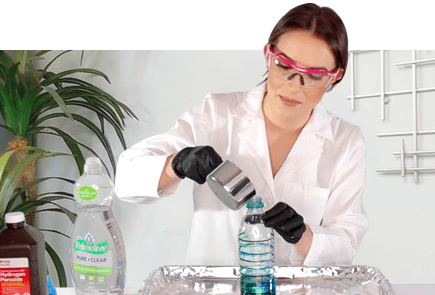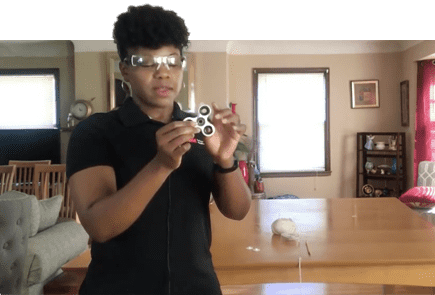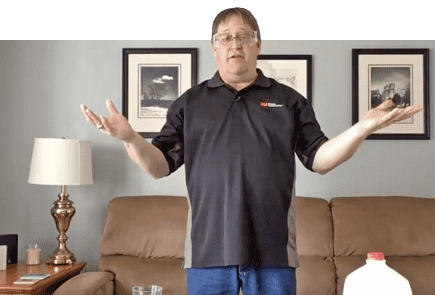Have you ever wondered how bubbles form? Learn the answer by joining special guest Kate the Chemist as she shows you how to make a bright and beautiful bubble snake using just a few simple materials.
Background
Bubbles are pockets of soap and water that are filled with air – like your breath, which contains nitrogen, oxygen and carbon dioxide. When you combine soap and water together then blow air into the mixture, the soap forms a thin wall and traps the air – creating a bubble! The soapy film is composed of three layers: one layer of water molecules between two layers of soap molecules. Millions of these molecules will stick together to form the spherical shape of a bubble.
Key Concepts
- Chemistry
- Gases
- Molecules
Materials
- An adult helper
- 1 small plastic bottle
- 1 thin towel (or sock)
- 1 rubber band
- 3-4 drops of food coloring (variety of colors)
- ½ cup water
- ¼ cup dish soap
- 1 small bowl
- 1 precision knife or scissors
Preparation
- Have an adult use the precision knife or scissors to cut the bottom ½ inch off a plastic bottle.
- Use a rubber band to fasten the towel to the open side of the bottle.
- Add the water and dish soap to the small bowl. Swirl to stir.
- Add food coloring directly to the towel. Get creative here – try to make a fun pattern!
- Dip the towel into the soap solution.
- Blow with force into the mouthpiece of the plastic bottle.
- Check it out – you’ve just made a bubble snake!
Observation and Results
Why did we add dish soap to the water solution?
What is the gas trapped inside of the bubbles?
What will happen if you double the amount of dish soap in the water solution?
What will happen if you use a 3-liter soda bottle? Will the bubbles be bigger?
What will happen if you use a thick towel instead of a thin towel?
The towel plays an important role in this experiment, as the dish soap is absorbed into the towel fibers until we use our breath to push our exhaled gas into a bubble.
You may notice some towels work better than others; the best ones are thick enough to absorb the bubble solution, but thin enough that you are can easily push air through the fibers.
And why do we add the food coloring to the towel instead of the water solution? Ideally, we want to create a multicolored chain of bubbles. If we add the food coloring to the towel, we can maintain sections of orange, red, green, blue, purple or whatever colors you chose! This is perfect for creating a rainbow bubble snake. However, if we had added all of these colors to the water solution, our water would turn dark black. That solution would give us a chain of black bubbles instead of a colorful bubble snake!
Keep trying out different color variations, different towel sizes, and make your observations.
When you are finished, remember to clean up when you are done by disposing of or recycling your materials.
Safety First and Adult Supervision
- Follow the experiment’s instructions carefully.
- A responsible adult should assist with each experiment.
- While science experiments at home are exciting ways to learn about science hands-on, please note that some may require participants to take extra safety precautions and/or make a mess.
- Adults should handle or assist with potentially harmful materials or sharp objects.
- Adult should review each experiment and determine what the appropriate age is for the student’s participation in each activity before conducting any experiment.
Next Generation Science Standard (NGSS) Supported - Disciplinary Core Ideas
This experiment was selected for Science at Home because it teaches NGSS Disciplinary Core Ideas, which have broad importance within or across multiple science or engineering disciplines.
Learn more about how this experiment is based in NGSS Disciplinary Core Ideas.
Engineering Design (ETS)1: Engineering Design
Grades K-2
- 2-PS1-1. Different kinds of matter exist and many of them can be either solid or liquid depending on temperature. Matter can be described and classified by its observable properties.
- 2-PS1-2. Different properties are suited to different purposes.
- 2-PS1-3. A great variety of objects can be built up from a small set of pieces.
Grades 3-5
- 5-PS1-1.
- Matter of any type can be subdivided into particles that are too small to see, but even then, the matter still exists and can be detected by other means.
- A model shows that gases are made from matter particles that are too small to see and are moving freely around in space. This can explain many observations, including the inflation and shape of a balloon and the effects of air on larger particles or objects.
- 5-PS1-2. The amount (weight) of matter is conserved when it changes form, even in transitions in which it seems to vanish.
- 5-PS1-3. Measurements of a variety of properties can be used to identify materials.
Grades 6-8
- MS-PS1-1.
- Substances are made from different types of atoms, which combine with one another in various ways.
- Atoms form molecules that range in size from two to thousands of atoms.
- Solids may be formed from molecules, or they may be extended structures with repeating subunits.
- MS-PS1-1-2, 3.
- Each pure substance has characteristic physical and chemical properties that can be used to identify it.
- MS-PS1-4.
- Gases and liquids are made of molecules or inert atoms that are moving about relative to each other.
- In a liquid, the molecules are constantly in contact with others.
- In a gas, they are widely spaced except when they happen to collide.
- In a solid, atoms are closely spaced and may vibrate in position but do not change relative locations.
- The changes of state that occur with variations in temperature or pressure can be described and predicted using these models of matter.
Grades 9-12
- HS-PS1-1. Each atom has a charged substructure consisting of a nucleus, which is made of protons and neutrons, surrounded by electrons.
Grades 3-5
- 5-PS1-4. When two or more different substances are mixed. A new substance with different properties may be formed.
Grades 6-8
- MS-PS1-2. Substances react chemically in characteristic ways.
- MS-PS1-3. In a chemical process, the atoms that make up the original substances are regrouped into different molecules, and these new substances have different properties from those of the reactants.
Grades K-2
- K-PS2-1. Pushes and pulls can have different strengths and directions.
- K-PS2-2. Pushing or pulling on an object can change the speed or direction of its motion and can start or stop it.
Grades 3-5
- 3-PS2-1. Each force acts on one particular object and has both strength and direction. An object typically at rest has multiple forces acting on it., but they add to give zero net force on the object. Forces that do not sum to zero can cause changes in the object’s speed or direction of motion.
- 3-PS2-2. The patterns of an object’s motion in various situations can be observed and measured; when that past motion exhibits a regular patter, future motion can be predicted from it.
Grades 3-5
- 3-PS2-1. Objects in contact exert forces on each other.
Explore Additional Science at Home Videos and Activities

Elephant Toothpaste
Join Camille Schrier, a scientist who was crowned Miss America 2020, as she shows you how to make a chemical reaction so big it’s fit for elephants!

Fidget Spinner
Your teacher might not love when you have one in class, but the physics behind fidget spinners are truly head-spinning!
Join 3M scientist Tesha R.-Alston Dampier as she shows you how a spinning motion changes the way things move.

Liquid Fireworks
Join 3M scientist Jeff Payne as he uses nothing more than milk, dish soap, and a few other kitchen supplies to get the amazing effects of fireworks without using any fire at all.

